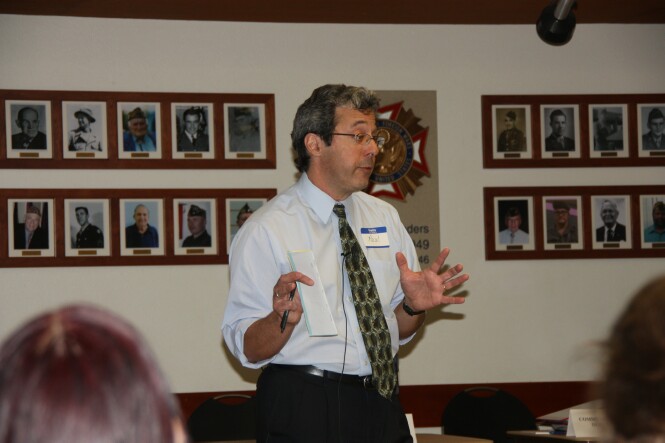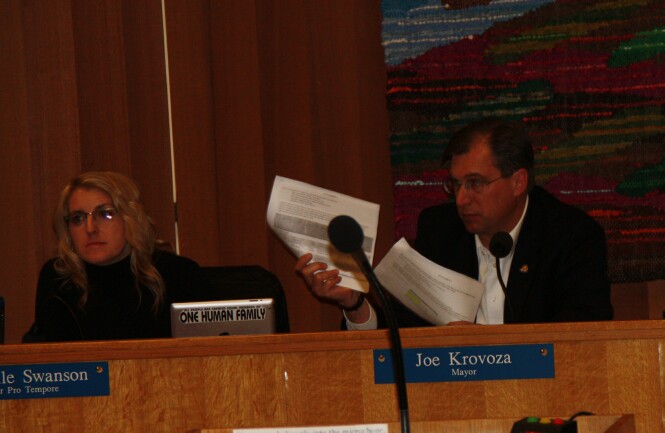Guest Commentary: Do Davisites Really Want To Help Our Schools And City???
By Michael Bisch It has been an interesting journey to date on the road to the June…
By Michael Bisch It has been an interesting journey to date on the road to the June…
 by Robb Davis
by Robb DavisWhen the Davis Chamber PAC announced its City Council Candidate endorsements in late April, spokesperson Steve Greenfield noted that there are three legs of sustainability for vibrant community: social sustainability[1], environmental sustainability and economic sustainability. At the event Mr. Greenfield noted that the last leg-economic sustainability-was what businesses, and the Chamber PAC needed to focus on. Even though Mr. Greenfield did not define “sustainability” it is clear that he and the Chamber PAC were suggesting that a vigorous community is one that is able provide a broadly healthy environment for its citizens today AND have in place policies and practices that will enable the continual renewal of the resources necessary for a healthy community into the future.
The Chamber PAC has provided some sense of their definition of economic development, including what economic sustainability might look like. Further, I assume that many of us have ideas around the meaning of environmental sustainability even if we do not agree with all the details about how to achieve it. If the business community and the Chamber PAC are the “champions” of economic sustainability, it would seem that organizations like the Sierra Club or the Cool Davis Initiative would be natural “champions” for this “leg” of sustainability.
 by Matt Williams
by Matt WilliamsThursday afternoon Kemble Pope, the Executive Director of the Davis Chamber of Commerce sent out the following e-mail:
City Council & Members of the Water Advisory Commission,

The high point of last night’s Water Advisory Committee meeting was the vote on the following motion, originally crafted by Mark Siegler, Bill Kopper and Frank Loge, and after discussion motioned by Alf Brandt and seconded by Michael Bartolic and Steve Boschken (don’t ask me to explain why there were two seconds).
The Water Advisory Committee (WAC) supports a project that involves conjunctive use under the provision that the WAC still needs to address the issues of 1) when the project should be implemented [e.g. immediately, in 5 to 10 years, in 20 to 30 years, etc.], 2) the size, cost and financing of the project, and 3] the source of treated surface water [e.g. Woodland/Davis JPA, West Sacramento, or other source]. In addition, in further deliberation, the WAC may identify other issues.
 Back in April, the City of Davis was able to take advantage of the vacancies in fire management positions to create a separate MOU for the vacant fire management employee positions.
Back in April, the City of Davis was able to take advantage of the vacancies in fire management positions to create a separate MOU for the vacant fire management employee positions.
As the staff report noted, “During the last round of negotiations, the previous management incumbents of the Fire Department requested the City pull the Fire positions out of the Individual Management Employees MOU and create a separate contract for these employees.”
![]()
Let me start by saying that the opinions and perspectives presented here in this article are those of the author and not the opinions and perspectives of the Water Advisory Committee (WAC).
Back on February 26th I wrote an article in the Vanguard that identified the informal water interest groupings here in Davis, specifically, 1) those Davis residents/citizens who opposed the September 2011 Joint Powers Authority Surface Water Plan (“the JPA Plan”) outright, and 2) those Davis residents/citizens who are concerned about one or more aspects of the JPA Plan, but don’t as yet oppose it in its entirety. Today, lets look at how the WAC activities to date have addressed the concerns of those groups.

Question: On September 6, the City Council passed water rates that some believed to be flawed. As a result, there was a referendum drive that ultimately obtained enough signatures to put the matter to a vote. The council then on December 6 rescinded the rate increase and set forth the current process. The question: Absent the referendum drive, would these changes have occurred and therefore do you believe that as a result of the referendum drive, we will get a better water project and fairer rates, why or why not?
 By a 4-1 vote, the City Council approved authorization of a consultant agreement with the West Yost/Malcolm Pirnie Team to provide city representative services for the Secondary and Tertiary Improvements Phase of the Wastewater Improvements Project.
By a 4-1 vote, the City Council approved authorization of a consultant agreement with the West Yost/Malcolm Pirnie Team to provide city representative services for the Secondary and Tertiary Improvements Phase of the Wastewater Improvements Project.
The four million dollar agreement was finalized very late Tuesday night or early Wednesday morning.
 Councilmember Greenwald Concerned with Using West Yost, Given Track Record
Councilmember Greenwald Concerned with Using West Yost, Given Track RecordThe city staff is recommending the council approve a resolution that would authorize City Manager Steve Pinkerton to execute a consultant agreement with the West Yost/Malcolm Pirnie Team to provide City Representative services for the Secondary and Tertiary Improvements Phase of the Wastewater Improvements Project (CIP No. 8219).
The proposed City Representative consultant agreement is for a not-to-exceed amount of $3,990,000; these funds are budgeted in CIP No. 8219 (Fund 532 – Sewer Capital Replacement Fund). It is the first portion of a forecasted total not-to-exceed fee of $5,390,000 for City Representative fees.
 Is this the right time to give the Davis City Council a raise for the first time in twelve years? In the next four months we will hear buzzwords like shared sacrifice coming from the council, as they ask city employees to take pay cuts and pay more of their retirement pensions, but three members of the council still believed this was the correct time in which to vote a raise that will take effect after the next council is seated.
Is this the right time to give the Davis City Council a raise for the first time in twelve years? In the next four months we will hear buzzwords like shared sacrifice coming from the council, as they ask city employees to take pay cuts and pay more of their retirement pensions, but three members of the council still believed this was the correct time in which to vote a raise that will take effect after the next council is seated.
The council also voted 4-1 to make changes in their health care plans that they will believe will ultimately save the city a modest amount of money, allowing the councilmembers to exercise a deferred cash-out plan of $500 per month rather than taking the more expensive full health care plan. (Details of both proposals can be read in this article from last week.)
 Daniel Borenstein, a columnist for the Contra Costa Times, recently had an interesting piece on pensions and the CalPERS risk that he argues will put future generations at big risk. It makes some interesting points, but perhaps goes too far and falls apart on key points.
Daniel Borenstein, a columnist for the Contra Costa Times, recently had an interesting piece on pensions and the CalPERS risk that he argues will put future generations at big risk. It makes some interesting points, but perhaps goes too far and falls apart on key points.
One of the critical issues facing the state is how much profit the fund expects over a 30-year period. This is critical because the California Public Employees’ Retirement System defines the benefits received by its recipients so that the less money the fund expects to make over the next thirty years, the higher the contributions need to be.
 I remember the first time I saw the road maintenance report. It was a few years ago, but it was an eye-opener precisely because no one was talking about it. There is often a disconnect, I think, when we bring this topic up. Overall right now, the roads in Davis are okay, but they are a veritable patchwork – with the main thoroughfares utilizing the bulk of the funding and the side streets wearing and tearing.
I remember the first time I saw the road maintenance report. It was a few years ago, but it was an eye-opener precisely because no one was talking about it. There is often a disconnect, I think, when we bring this topic up. Overall right now, the roads in Davis are okay, but they are a veritable patchwork – with the main thoroughfares utilizing the bulk of the funding and the side streets wearing and tearing.
But what we need to understand is that last year’s report showed that the city had a baseline funding shortfall of $1.62 million. In the past, the city has relied heavily on one-time funding over the past two years from Proposition 1B and Federal Stimulus funding. However, that money is gone and those funding sources are gone with them.
 We have had wake up call after wake up call this year. It actually started last fall, when the council was informed by city staff that, in effect, they would not be implementing the budget that was passed back in June.
We have had wake up call after wake up call this year. It actually started last fall, when the council was informed by city staff that, in effect, they would not be implementing the budget that was passed back in June.
We have seen an impasse blow up in our face. We have seen the demise of the fire department merger, which is probably dead for good unless we find a way to gain parity in compensation. We have seen the prospects for budgets without massive layoffs dissipate in front of our eyes.

The Vanguard reported in March that the UC Davis-City of Davis Fire Merger was being paused, and some officials believe it is, in fact, dead. The Vanguard obtained a January 12, 2012 letter through a Public Records Act request from UC Davis Vice Chancellor John Meyer.
Contained in that letter was another kernel that the Vanguard has followed up on with another public records request.
 A fascinating discussion broke out on Facebook late yesterday when Bernie Goldsmith revisited the city council’s late 2010 decision to bank with Wells Fargo rather than more local banking institutions. The decision ultimately came down to hard numbers, something that Mr. Goldsmith disputes.
A fascinating discussion broke out on Facebook late yesterday when Bernie Goldsmith revisited the city council’s late 2010 decision to bank with Wells Fargo rather than more local banking institutions. The decision ultimately came down to hard numbers, something that Mr. Goldsmith disputes.
He writes, “I think it is a core value of this town that we should support our local businesses, institutions, and service providers, even when it’s a little more expensive.” He adds, “This is because we know that the value of shopping locally is not always reflected directly in dollars and cents or a bottom line; dollars spent locally recirculate and multiply more than dollars spent elsewhere, enriching businesses and government alike. This issue is deeper than a simple bottom line; it reaches to the bedrock of our community’s values, and what makes Davis unique.”

On the surface it seemed like a strange move. One that many did not see coming. Woodland hiring Davis’ finance director, who only six months previously had been the interim City Manager for Davis, and was passed over for promotion by the city council’s hiring of former Manteca City Manager Steve Pinkerton.
Put into the all-important sports analogy terms, it would be like the Dodgers not hiring their pitching coach who had served as interim manager, and then after the season ended, the Giants going ahead and hiring that pitching coach to manage their club.

In a press release from the City of Woodland, it states Mr. Navazio comes to the city with 20 years of experience in municipal government. He is currently the Assistant City Manager for the City of Davis, California, where he has direct responsibility for Budget, Finance and Information Technology Services, in addition to assisting with all city departments, initiatives and projects.
 by Matt Williams –
by Matt Williams – Let me once again start by saying that the opinions and perspectives presented here in this article are those of the author and are not the opinions and perspectives of the Water Advisory Committee (WAC).
Unlike the meetings before it, meeting number 7 of the WAC contained virtually no discussion of how the WAC should conduct its activities, votes and recommendations. If the WAC is following Tuckman’s stages of group development, also known as the “Forming-Storming-Norming-Performing” model of group development, then the WAC appears to have successfully completed the Storming stage and will hereafter be concentrating on Norming and Performing.

We must first acknowledge that the budget picture is not a uniformly negative one. After years of a council and staff in denial, it is clear that at least the council and the upper levels of city government proverbially understand the nature of the problem.
At the same time, what the time that has elapsed since the June budget was passed by a 3-2 vote, with the lack of clear progress made toward those directives in the nearly nine months since, illustrates is that one cannot simply wave a wand and make the budget problems go away. No matter how well-intentioned those in charge now may be, it is simply too deep a mess.

Earlier in the week, the Vanguard highlighted problems with a consent item on the budget which was listed as an informational item, but, however, included at least one critical change in council policy with regard to the personnel compensation cuts.
In addition, there was another consent item which established an individual management MOU for fire management employees.